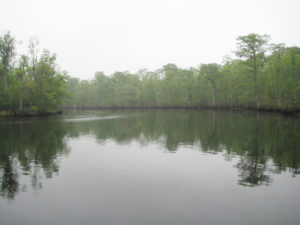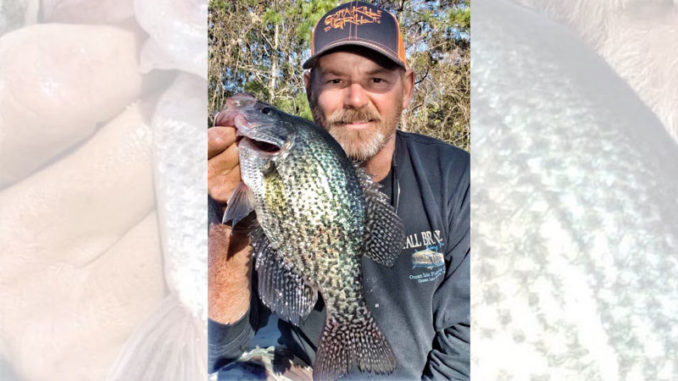
Put February slabs in the cooler
According to the National Oceanographic and Atmospheric Administration, February is the coldest month, with average low temperatures dipping into the 30s on a daily basis across the Carolinas. But Waccamaw River crappie don’t mind.
Many anglers believe that fish seem to go into hibernation along with black bears, but that couldn’t be further from the truth, especially for freshwater lairs teeming with America’s favorite speckled-sided panfish.
While most serious crappie fishermen concentrate on inland reservoirs to get their limits, the tea-stained, blackwater coastal rivers are an excellent option to find schooled-up black crappie in the winter. The Waccamaw River, which flows across several counties in both Carolinas, is often overlooked but is a great destination for slabs.
The Waccamaw is full of fan favorites, including catfish, largemouth bass, bream and crappie. It is extremely fertile, with excellent habitat. Draining more than 1,100 square miles, the river originates in southeastern North Carolina, beginning as a small stream coming out of Lake Waccamaw and a massive collection of Carolina bays within its headwaters. Along its course, the river runs along the boundary between North Carolina’s Columbus and Brunswick counties and then bisects South Carolina’s Horry County through Conway to empty in Winyah Bay and the Atlantic Ocean in Georgetown County.
Ideal crappie habitat
Along its route, the river twists and turns through ancient, cypress/gum swamplands that have created a system of braided channels, well-developed interstream divides, and healthy oxbow lakes that make ideal homes for crappie.
Guide Todd Vick of Fishin’ Freshwater Charters of Socastee, S.C., is a premier crappie-fishing expert along the Waccamaw system. He targets slab in the river from up above Conway to Sandy Island near Pawleys Island, and chilly conditions concentrate crappie in smaller areas of the river.
“When the water temperatures dip below 50 degrees, the fish start looking for a more stable environment in deep holes without much current,” Vick said. “Crappie avoid current in winter so they can sit idle and use the least amount of energy as possible.”
The Waccamaw may not be as deep as other rivers in North Carolina’s Piedmont and South Carolina’s Midlands and Upstate. But deep channels and oxbow lakes with sufficient depths support the desires of a wintering crappie population.
Trust your electronics to find crappie
“I will go from fishing the 8-foot dock line in the fall to 26-foot holes on high tide,” he said.
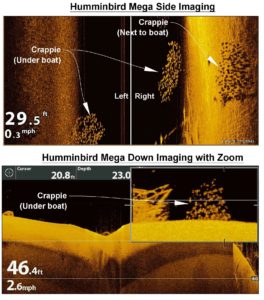 Finding schooling crappie requires good marine electronics. And a high-definition unit with side-scanning technology can put anglers on fish much more quickly than ever before.
Finding schooling crappie requires good marine electronics. And a high-definition unit with side-scanning technology can put anglers on fish much more quickly than ever before.
“You can see them on the graph, and when you find them, they will be in packed in there, practically blacking out the bottom half of the screen,” he said.
High-definition and side-scanning units like Humminbird’s Solix Mega Series allow anglers to see in great detail what is below and on each side of their boats out to 100 feet. You can make one pass across a deep spot and can see fish and structure anywhere if they’re under the boat or out to 50 feet to the port or starboard sides. This is helpful because winter crappie will hold in tight schools on specific spots, especially with good structure or cover.
“If you have structure in these holes, it’s an added bonus; fish will associate with the structure,” he said.
Pay close attention to the depth fish are holding
In addition to finding places that are holding fish, electronics can identify the depth fish are holding. Typically, crappie will be lying at or near the bottom in the winter, but changes in conditions can cause fish to move temporarily to the middle section of the water column.
“Crappie only look up to feed. If you get below them, you will not get any bites. I like to be 6 inches to a foot above them,” said Vick. “Typically, they are on the bottom this time of year that makes it easier to fish above them.”
Even when acting sluggish in cold water, crappie will feed whenever an easy meal shows up, and small minnows and small jigs will produce the best results.
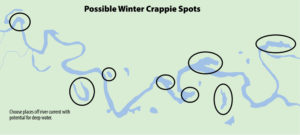 “I like to downsize my bait in the wintertime,” Vick said. “Crappie can be finicky, and even more so in the winter. I use from 1/32- to 1/64-ounce jigs with 1-inch soft plastics. You need to make it as appetizing as possible ,and they turn on to smaller-sized presentations.”
“I like to downsize my bait in the wintertime,” Vick said. “Crappie can be finicky, and even more so in the winter. I use from 1/32- to 1/64-ounce jigs with 1-inch soft plastics. You need to make it as appetizing as possible ,and they turn on to smaller-sized presentations.”
Vick said he’ll alternate between using only a jig and soft plastic,, a jig tipped with a small minnow or just a minnow on a hook.
“I will experiment with different setups and colors until they take the bait. When they eat, you can follow that same technique and load up on them. But don’t be scared to experiment to find that perfect combination,” he said.
Don’t get jiggy with it!
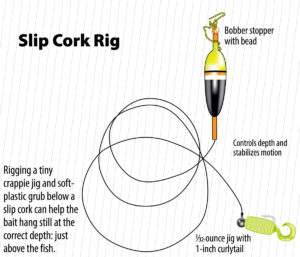 Fishing for crappie in winter isn’t for everybody — unless anglers want to catch slab-sized fish on every trip. Cold weather will soon be forgotten when the fish start coming aboard.
Fishing for crappie in winter isn’t for everybody — unless anglers want to catch slab-sized fish on every trip. Cold weather will soon be forgotten when the fish start coming aboard.
Small jigs and soft-plastic baits are the go-to lures for catching crappie for most of the year, including the winter.
But be careful to use the word “jig” only as a noun, not as a verb.
Guide Todd Vick of Freshwater Fishing Charters out of Socastee, S.C., said a lure’s action — or lack thereof — is the most-important aspect to becoming a successful crappie angler in winter.
“You should be vertically jigging this time of year, but you shouldn’t be actually jigging the lure,” Vick said. “The natural movement of the boat is all you need. Just hold it still and let the fish come to the bait.”
Vick will sometimes fish his jigs under a slip cork to control his depth effectively and to keep the bait as still possible.
“A bobber is a good way to slow the jig down and reduce movement. Let the action of the water work the lure,” he said.
The lake by the same name
Larry Williamson sat in his johnboat, a paddle in one hand and a pole in the other. Sculling gently, he inched the boat along the shoreline of Lake Waccamaw.
“I move the boat just enough to keep the lines straight,” he said. “So I guess I am an old-school crappie fisherman. I don’t pull minnows along. They should swim naturally to get the attention of big crappie.”
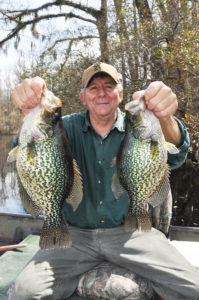
Williamson, 71, from Hallsboro, N.C., fishes three days a week for crappie at Lake Waccamaw, an 8,938-acre Carolina Bay Lake in Columbus County, N.C., from which the Waccamaw River originates. He said the winter is great for fishing.
“There aren’t as many fishermen out when it’s cold,” he said. “But crappie like cold water.’
Williamson’s johnboat trailed four, inch-long cork bobbers under carbon-fiber poles: 13-foot Black Widows. Occasionally, he lifted a rod, checked a wriggling shiner on a No. 6 gold hook and lobbed it back gently.
This river has true slab crappie
A bobber went down as a crappie made off with a minnow. Williamson lifted the rod gently and the fish put a big bend in the rod. It struggled while he held it in place, not pulling too hard or bringing it to the boat too fast so it could not pull out the hook. He kept lifting the rod until the fish was beside the boat. Dipping it from the water with a small landing net, he unhooked it and held it by its lower jaw.
“That’s a real rooster,” he said. “It will top 2 pounds.”
Williamson often catches more than a dozen black crappie on a winter trip to Lake Waccamaw, especially when he finds them ganged up around brush piles.
“I fish the canals all around the lake and the lake itself,” he said. “A lot of boat docks have trees tied under them. You can see ropes tying the trees to the docks. Some fishermen put trees in plastic buckets filled with concrete and sink them out in the lake. Any manmade structure attracts crappie because the lake doesn’t have much natural cover.”
Destination Information
- HOW TO GET THERE — The Waccamaw River is easily accessible between Conway and Georgetown, with nearly a dozen public boat landings along its length. For specific locations of landings, visit www2.dnr.sc.gov/ManagedLands/boatramp/boatrampsearch.
- WHEN TO GO — The winter crappie bite begins around Christmas when the water temperatures dip into the low 50s and will continue until the water temperatures warm in the spring.
- BEST TECHNIQUES — Look for fish in deep holes in oxbows or other places along the river where there is little or no current. Crappie will bite extremely small jigs in winter, 1/32- to 1/64-ounce, with 1-inch tubes, curlytail or paddletail grub. Productive colors include black/chartreuse, white/chartreuse, blue/chartreuse, chartreuse and pink/white. Drop jigs slightly above depth crappie are holding. Keep your bait still; slip corks can be used to fish the correct depths and to keep baits still. Use light, sensitive rods and reels spooled with 6-pound monofilament.
- FISHING INFO/GUIDES — Todd Vick, Fishin’ Freshwater Charters, 843-333-8200. See also Guides & Charters in Classifieds.
- ACCOMMODATIONS — Hampton Inn, Murrells Inlet, S.C., 843-651-6687; Best Western, Conway, S.C., 843-234-1678; Myrtle Beach Area Convention and Visitors Bureau, www.visitmyrtlebeach.com.
- MAPS — DeLorme’s S.C. Atlas & Gazetteer, 207-846-7000, www.delorme.com.

